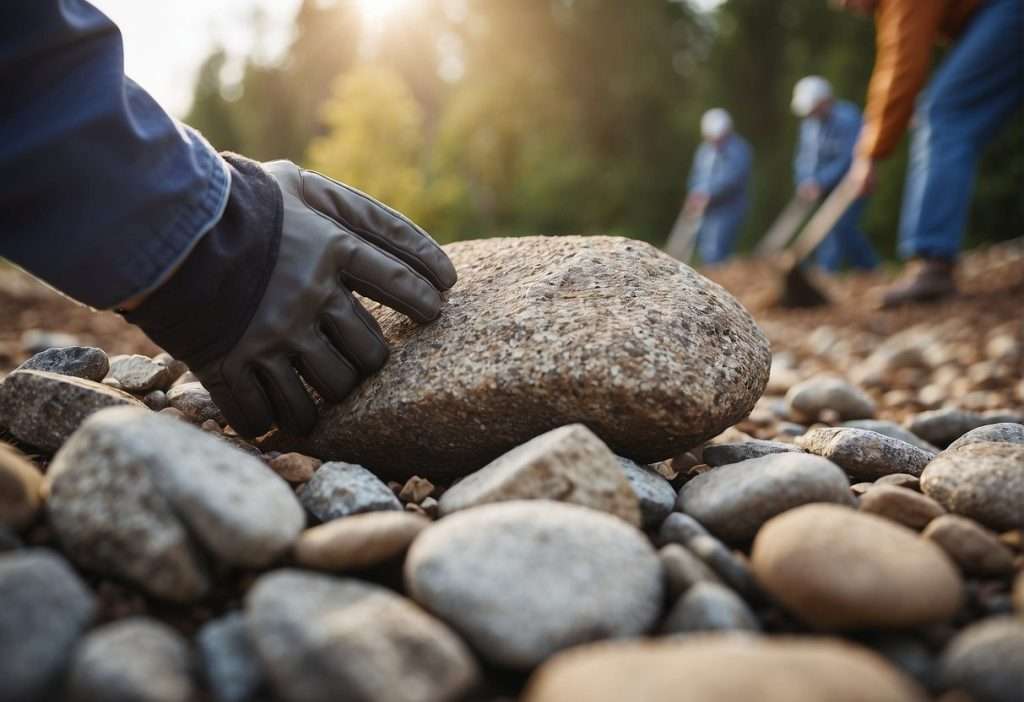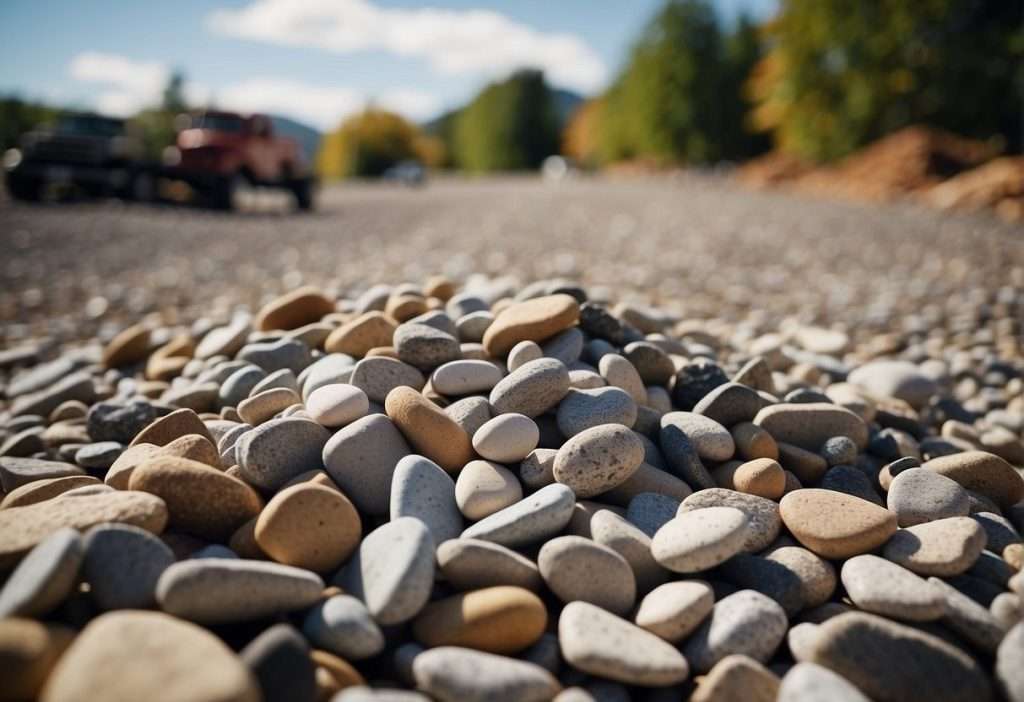When you’re updating your garden or clearing out landscape materials, you might find yourself with an excess of landscaping rocks. It’s important to dispose of these rocks properly, not only for environmental reasons but also to comply with local disposal regulations. Knowing where and how to get rid of these rocks can save you time and help maintain the cleanliness of your living space.

Landscaping rocks come in various types, including pebbles, gravel, and large decorative stones. Each type may require a different method of disposal. Some local waste management services may offer specific guidelines for rock disposal, while other areas may have dedicated facilities for construction and landscaping materials. Before you start, check with your local authorities or waste disposal services for the most accurate and up-to-date information.
Additionally, consider recycling or repurposing the rocks. Other homeowners, landscaping companies, or community projects might find a use for them. Online marketplaces and community boards often have sections where you can offer your rocks, either for sale or for free. Repurposing these materials can be a particularly eco-friendly solution, minimizing the need for new resources and reducing the landscaping rocks’ impact on the environment.
Understanding Landscaping Rocks
When considering the removal or replacement of landscaping rocks, it’s essential to recognize the varied types of rocks used in landscaping and understand the ramifications of their disposal on the environment.
Types of Landscaping Rocks
- Pea Gravel: Small, rounded stones commonly used for pathways or as decorative mulch.
- River Rock: Larger, smooth stones typically utilized for accentuating garden beds or water features.
- Decomposed Granite: Finely crushed rock that provides a rustic look and is used for walkways or driveways.
- Lava Rock: Lightweight, porous stones with a unique appearance, often applied in areas needing good drainage.
- Crushed Stone: Sharp, angular fragments used for their stability in projects like driveways or base materials.
Environmental Impact of Rock Disposal
Disposing of landscaping rocks may have unintended environmental consequences. Here are some considerations:
- Sustainability: Reusing or repurposing rocks can conserve natural resources and reduce the need for new material extraction.
- Habitat Disruption: Inappropriate rock disposal can disturb local ecosystems or alter the natural landscape.
- Transportation Footprint: Transporting rocks can result in significant carbon emissions, especially if the disposal site is far from your location.
Options for Disposal
When disposing of landscaping rocks, you have several straightforward options to consider. Whether you’re looking to donate, recycle, or utilize professional services, the following methods offer efficient solutions for managing your excess materials.
Donating Landscaping Rocks
- Contact Local Organizations: Schools, parks, and community gardens sometimes welcome donations of landscaping rocks.
- Use Online Platforms: Websites such as Freecycle or Craigslist allow you to post your rocks for free to interested parties in your area.
Recycling Rocks
- Recycling Centers: Reach out to your local recycling center to discover if they accept landscaping rocks for recycling.
- Construction Material Companies: Some companies might take rocks to crush and reuse for other projects.
Using a Junk Removal Service
- Hire a Professional: Junk removal companies can handle the heavy lifting and transportation of your landscaping rocks to the appropriate disposal sites or recycling centers.
- Cost-Effective: While this service usually incurs a fee, it saves you time and potential injury.
Renting a Dumpster
- Temporary Solution: Renting a dumpster can be a viable option if you are undertaking a large landscaping project with a significant amount of rock waste.
- Local Waste Management Regulations: Be sure to adhere to waste management policies regarding the disposal of landscaping rocks to prevent any violations.
Repurposing Landscaping Rocks
When you repurpose landscaping rocks, you not only save money but also contribute to a sustainable environment. Your creativity can transform these rocks into practical and attractive elements for your outdoor space.
In Garden Settings
Retaining Walls: Repurpose your large, flat rocks to build a retaining wall that can elegantly define flower beds or elevate your garden beds, creating a multi-dimensional appeal. Choosing rocks that fit snugly together is crucial for stability.
Pathways and Stepping Stones: Small to medium rocks are perfect for creating pathways or stepping stones through your garden. Use them to lead visitors on a journey through your flower beds, or to discourage walking on sensitive areas.
Rock Gardens: If you have an assortment of rocks, consider constructing a rock garden. This can be a striking feature that requires minimal maintenance and provides excellent drainage for succulents and other rock-loving plants.
For Home Projects
Fire Pit: Transform your backyard by using your old landscaping rocks to build a fire pit. Safety first: ensure that the rocks are positioned securely and located well away from flammable structures and plants.
Walkways: Larger, flat rocks are ideal for walkways. By laying them out, you create a natural-looking path that’s both functional and aesthetic. Remember to install them on a bed of sand for leveling and stability.
How to Prepare for Disposal
Before you start disposing of landscaping rocks, it’s essential to gather them properly and ensure you are following safety protocols to prevent injuries.
Gathering and Cleaning
First, you’ll need to collect all the rocks. Use sturdy gloves to protect your hands from sharp edges and dirt. Employing tools like a shovel or rake can help you lift rocks more efficiently. Once gathered, it’s a good idea to rinse the rocks to remove any soil or organic material, making them more suitable for reuse if possible. For transport, a wheelbarrow will be indispensable, enabling you to move heavy loads with ease.
Safety Tips
Safety should be your top priority. Always wear thick gloves to prevent cuts and sturdy boots to protect your feet. When lifting heavy rocks, keep your back straight and lift with your legs to avoid strain. If you’re using a wheelbarrow, ensure the path is clear of obstacles to prevent tripping or spilling. In case of sharp or overly heavy rocks, consider using additional protective gear like safety goggles or a back brace, and don’t hesitate to ask for assistance to share the load.
Finding Disposal Services
When you need to dispose of landscaping rocks, various services can facilitate the process. It’s important to consider online platforms for free or paid transactions, as well as professional local landscaping companies that may accept or repurpose your rocks.
Online Marketplaces
- Craigslist: You can list your landscaping rocks for free or for sale in the “Free” or “For Sale” sections, respectively. Interested local individuals or companies can arrange to pick them up.
- Facebook Marketplace: This platform allows you to reach a wider local audience. You can list the rocks for free or set a price, including photos and specific details about the quantity.
- Freecycle & Freecycling Groups: Post your landscaping rocks on Freecycle, where community members exchange items at no cost. Also, look for local freecycling groups on social media platforms.
Local Landscaping Companies
- Contact Landscapers Directly: Reach out to local landscaping companies to inquire if they’re interested in your rocks. Many are willing to take them off your hands for their projects.
- Offer to Local Landscaper Forums: Post an offer on landscaping forums or message boards. Professional landscapers often visit these sites seeking supplies.
Legal and Community Considerations

When looking to dispose of landscaping rocks, it’s important to consider both legal stipulations and how you can benefit your community. Familiarizing yourself with area-specific regulations and discovering local community projects can ensure responsible disposal.
Compliance with Local Regulations
Before disposing of your unwanted landscaping rocks, check the local regulations in your area. Many municipalities have specific guidelines for the disposal of construction and landscaping materials. For instance, you might find regulations that forbid leaving rocks in public or protected areas due to environmental concerns. Contact your local waste management service or visit their website to find detailed information about acceptable disposal methods and potential recycling options. Here’s a quick checklist to help you:
- Verify local disposal laws and ordinances.
- Research restrictions on landscape waste.
- Find designated drop-off locations for materials.
Engaging with Community Gardens and Projects
Community gardens and local landscaping companies often seek out donations of landscaping materials, including rocks, to enhance their projects. Locate community gardens or neighborhood projects by connecting with local horticulture societies or using community bulletin boards. Donating your rocks not only clears them from your property but also supports the community. A simple table to find the right fit for your rocks might look like this:
| Entity | Contact | Acceptance Criteria | Drop-off/Pick-Up |
|---|---|---|---|
| Community Garden | Phone/Website | Must be clean and pesticide-free | Arrange with coordinator |
| Local Landscaping Company | Phone/Website | Various sizes accepted | Typically pick-up |
| School/University Projects | Phone/Website | Useful for educational purposes | Drop-off preferred |
Ensure that the organization or company you choose complies with the local regulations to maintain a responsible and mutually beneficial exchange.
Conclusion
When considering the disposal of landscaping rocks, you have multiple avenues to responsibly and efficiently handle the task:
- Local Landscaping Companies: Reach out to these businesses to inquire if they can reuse your rocks.
- Online Platforms: List the rocks on websites like Craigslist or Freecycle where community members can claim them for personal projects.
- Waste Disposal Centers: Contact your local waste disposal centers to check their policies on rock disposal.
Remember to avoid leaving rocks in natural areas or by the roadside, as this is often illegal and can harm the environment. The key points to keep in mind include responsibility, legality, and community resourcefulness. If you follow these guidelines, you can be confident that your landscaping rocks will find a new purpose.


